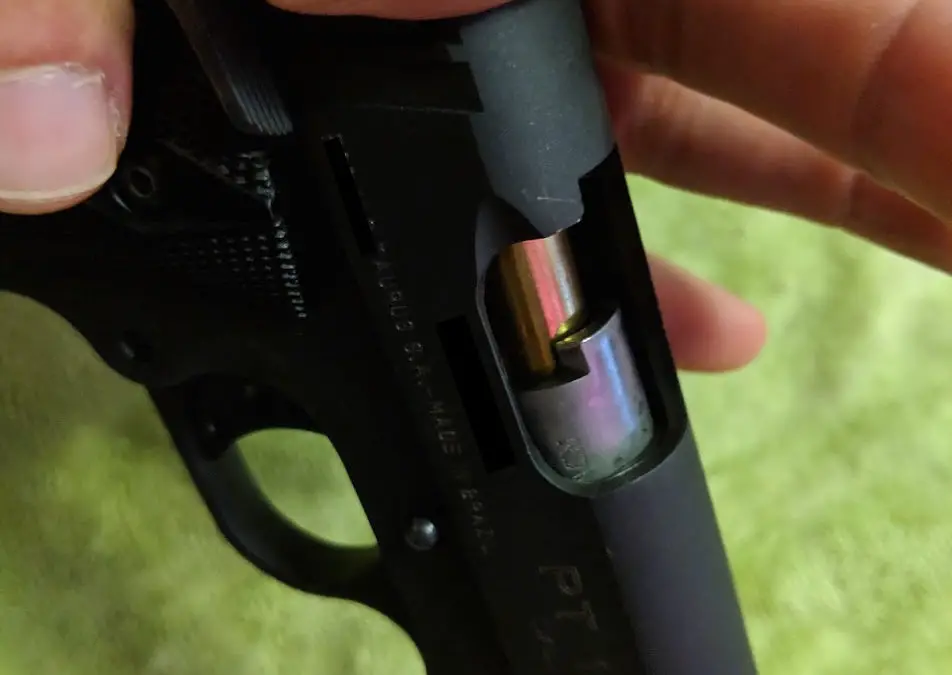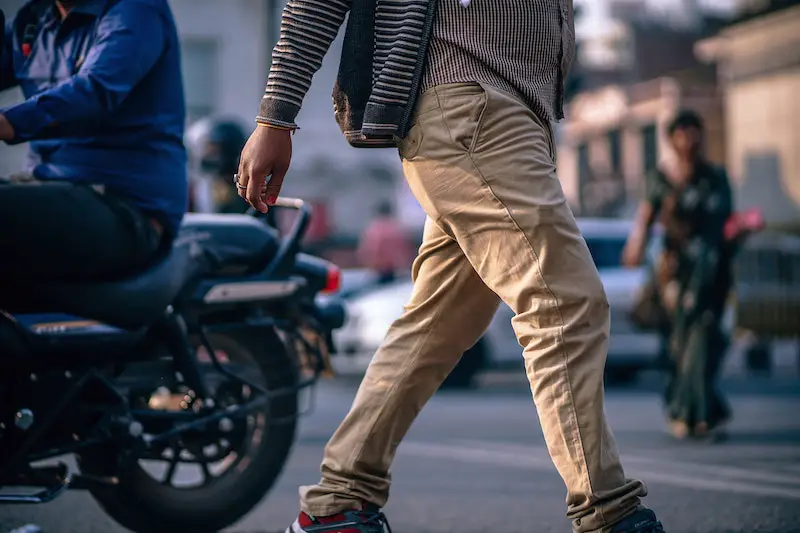New concealed carry permit holders always wonder about carrying a loaded firearm. Some people wonder whether it is safe to carry around a loaded firearm. Others worry that carrying a loaded firearm is illegal in their state. So today, I’m going to discuss everything you need to know about keeping a round in the chamber and safely carrying a loaded firearm as part of your everyday carry kit, whether openly or concealed.
Table of Contents
What Does It Mean To Chamber A Round?
If a weapon has a round in the chamber, it means the weapon has a cartridge loaded and once the safeties are disabled and the hammer is cocked, the weapon is ready to shoot. There are several ways to accomplish this, and it depends on the type of firearm you are using.
If you are using an automatic, you first open the action and lock the slide back. Next, you insert the magazine, and release the slide catch. Once this is complete, there is a round in the chamber, and the hammer is cocked. Another way to accomplish loading a round into the chamber is by inserting the magazine into your weapon. Afterwards, open the action by pulling back on the slide and releasing it allowing the spring tension to return it to the forward position. Again, the hammer will be cocked and there will be a round in the chamber.
When a guns capacity is listed as “10 + 1” it’s total capacity is 11 rounds. Ten rounds represent a full magazine, the “+1” represents the round in the chamber. For this reason, a fully loaded firearm must have a magazine loaded to capacity as well as a round in the chamber of the firearm.
Therefore, once you have loaded a round into the chamber, either drop the magazine, add a round and re-insert that magazine into the gun. Or, you can eject the magazine and replace with a fully loaded magazine to replace the original. Finally, you can manually insert a round by locking the slide rearward and placing a round into the open action, then releasing the slide catch. Afterwards insert a full magazine.
Weapon Conditions
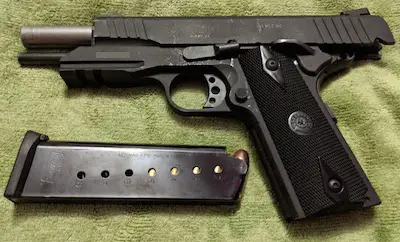
When handling a weapon, there are four different “conditions” the firearm can be in. Each condition is numbered. The first is condition 4, which means the weapon has been cleared. When a weapon is cleared, there is no round in the chamber and no magazine inserted in the gun.
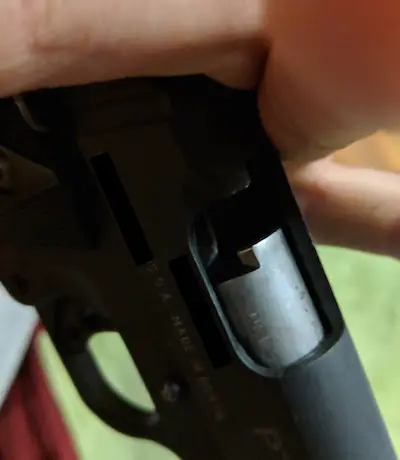
Next, is condition 3, where the weapon has a magazine inserted, but no round has been chambered. Many new concealed carry holders keep their weapons in this condition for everyday carry. They perceive it as the safest way to carry and do not question the legality. More on this later.
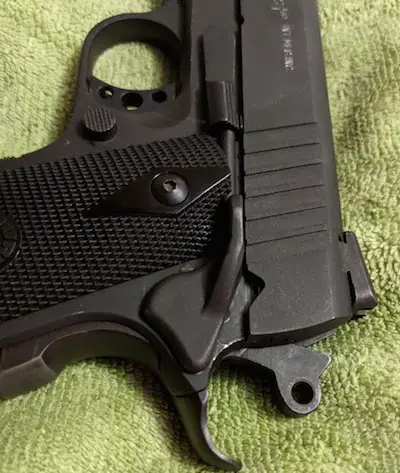
Condition 2 is when a gun has a magazine inserted, there is a round in the chamber with the hammer de-cocked. This prevents the hammer from falling and striking the firing pin, and thus, prevents the weapon from firing. In order to accomplish this, you’ll need to know how to lower the hammer on your weapon. This may mean maintaining control of the hammer while compressing the trigger. (The sample image to the left is not completely accurate, as the 1911 is in the half cock position)

When placing a weapon in condition 1, the magazine is inserted, and a round is chambered, and external safeties are engaged. For the purposes of this article, when we talk about carrying a round in the chamber, we’ll be considering the weapon in condition 1.
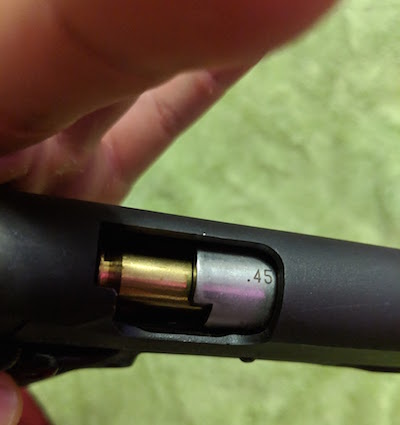
Finally, condition 0 means the weapon has the magazine inserted, a round in the chamber, and the safeties are disengaged. This condition is used when you are ready to use the weapon either on the range or to protect life and property. The image at the left shows the round in the chamber. However, the weapon will look like condition 1 but the safety will be disengaged.
Why Should I Carry With One In The Chamber?
Now that I’ve discussed how to put a round in the chamber, let’s discuss whether you should keep your gun loaded while carrying. As the saying goes, “when seconds count, the police are only minutes away.” Having your weapon loaded can save valuable time should you ever need to use your weapon.
I am not a competitive shooter, just your average concealed carrying gun enthusiast. Therefore, I conducted a series of tests to evaluate the amount of time saved when un-holstering, aiming, and firing my weapon. Also, I measured the difference in the distance covered by an assailant between un-holstering a gun in condition 2 versus a gun in condition 1. Furthermore, I did this for multiple methods of concealed carry and open carry. Below are the results.
Chambered Round vs. Empty Chamber Fire Times
I’ll start this section by stating that I am not a competition shooter. I wanted this to reflect the type of results an average shooter might experience, rather than a trained professional. The times below are a reflection of my draw and fire times. Although I did my best to eliminate as many variables from the equation, every shooter will have some variance in their draw and shoot times.
Constants For Experiment
For this experiment, I opted to use my EDC pistol, which is a Sig Sauer P250, which is a double action only pistol. Therefore, some delays may have occurred from a variance in the speed of my trigger pull.
For open carry, I used my Blackhawk CQC molded holster. Regarding my concealment shots, I opted to use the Alien Gear IWB holster. Because the ComfortTac bellyband and 5.11 tactical concealed carry shirt vary the draw location, I decided to not use these methods. The Sig does not have any external safeties, so there is no variance in time due to disengaging the safety.
Methodology For Experiment
My assistant running the stopwatch designated the start time, and stopped when the round was fired. Only one round was sent down range. Times are only listed when the target was struck center mass. The ammunition used was American Eagle 147 grain 9mm luger. My shooting position was a fighting stance, not the isosceles.
My stance remained constant throughout, so I did not have to position my feet prior to, or in the midst of, drawing my weapon. During the experiment, my hands were by my side, and were stationary while waiting for the queue to draw my handgun.
In addition, when testing the concealed draw method, the handgun was fully concealed. My shirt was un-tucked, and covering the pistol grip. Therefore, some variances may be due to difficulties exposing the gun in order to draw and fire.
Each shot was taken from a distance of 12 feet. For assessing the results, it took me (a 6 foot tall individual) approximately 4.25 seconds to cover that distance from a standing position, and a walking pace (normal gait). Below is a representation of the results.
Results Summary
The results of this test revealed a significant difference between draw and shoot times for both concealed and open carry platforms. First, the open carry platform varied .71 seconds on average between having a round in the chamber, and having to chamber a round before firing.
Second, the difference between condition 3 and condition 0 when drawing the weapon from being concealed was .75 seconds. Furthermore, you can expect to add about .12 seconds on average to your draw time between the concealed carry and open carry methods Therefore, I highly recommended to carry with one in the chamber if you are legally allowed to do so, but more on that later.
Depending on what weapon you carry, the safety features of that weapon, and your proficiency with the gun will all impact your time. Furthermore, your open carry or concealed carry method, can also vary your shot times. Finally, for those who believe that .75 second isn’t a great deal of time, consider this. In Olympic sports, the difference between first and second place in timed events is often decide by tenths of a second, sometimes hundredths of a second. When your life is on the line, do you really want to come in second place?
Concealed Carry Loaded Weapon Times
- 2.57 seconds
- 2.45 seconds
- 2.43 seconds
- 2.67 seconds
- 2.58 seconds
Average Time: 2.54 seconds
Concealed Carry Unloaded Weapon Times
- 3.46 seconds
- 3.05 seconds
- 3.49 seconds
- 3.36 seconds
- 3.09 seconds
Average Time: 3.29 seconds
Open Carry Loaded Weapon Times
- 2.00 seconds
- 2.40 seconds
- 2.62 seconds
- 2.53 seconds
- 2.55 seconds
Average Time: 2.42 seconds
Open Carry Unloaded Weapon Times
- 2.85 seconds
- 3.06 seconds
- 3.23 seconds
- 3.14 seconds
- 3.39 seconds
Average Time: 3.13 seconds
Is It Safe To Carry One In The Chamber?
First timers usually wonder about the safety of carrying a loaded firearm. It really depends on your own training, and whether you safely handle your weapon in general. Telling you that your weapon will never discharge accidentally, or due to a mechanical failure, would be a lie. I can’t predict the future. However, if you practice safe handling, and have the proper holster or carry method, you increase the likelihood that you can carry with one in the chamber without disastrous consequences.
Familiarize yourself with your weapon, and understand each of the external safety measures your pistol is equipped with. Do you have a grip safety? A grip safety is on the back of your pistol grip and prevents the trigger from being pulled without first compressing the grip safety. Another type of safety is the thumb safety. If you’re pistol has this safety feature, engage when the hammer is cocked to prevent it from falling. The more safety features your weapon has, the safer it is to carry with one in the chamber.
However, even weapons without a safety, such as my Sig P250, can be carried safely with a chambered round. Choosing the right holster can make a world of difference when you’ve got a round in the chamber.
Is It Legal To Keep A Round In The Chamber?
It’s always worth reviewing the gun laws within your state before deciding to carry a concealed pistol with a round in the chamber. However, in my research, I have not come across any states that forbids carrying a pistol with a round in the chamber, for those with a valid concealed carry permit or equivalent.
Different states have different definitions of what is considered a loaded gun. Some require the pistol to simply have a magazine inserted into the weapon (condition 3). Check the statutes of the state you will be carrying, because state reciprocity is not guaranteed. Furthermore, those carrying or transporting a firearm across state lines without a permit should certainly check what the state considers a loaded weapon.
Will The Gun Go Off If You Drop It?
While manufacturers take every precaution to ensure the safety of their firearms (lest they be hit with lawsuits) nothing can guarantee a gun will not go off if you drop it. With that being said, in my early days of concealed carry, I did have my weapon un-holster itself and fall to the ground. Fortunately, the weapon did not discharge on impact. However, many new firearm owners and concealed carry permit holders make the mistake of trying to catch a weapon that’s falling.
You’re far more likely to have your gun go off while attempting to grab it in the air, rather than recovering your firearm once it’s hit the ground. While safety protocol dictates that every weapon should be treated as if loaded, carrying with one in the chamber leaves no doubt. Because you’ve got a chambered round in the firearm, take the utmost care when collecting it and returning it to your holster.
How Long Can I Keep A Round In The Chamber?
Thus far, we’ve covered, why it’s wise to keep one in the pipe. However, how long can you keep a round in the chamber? I’d recommend that you not leave a round in the chamber for more than a couple of months, assuming you do not eject and re-chamber the round on a regular basis. If you are in the habit of unloading the weapon regularly, I would recommend you rotate the ammo every week, or at least every couple weeks.
Any environmental factors that can lead to the deterioration of your EDC ammunition will also impact the round you keep loaded. Furthermore, that round is not insulated by other rounds or the walls of the magazine. It is subject to increased exposure to any lubricating fluids you use on your weapon.
Personally, I do not leave a round in the chamber while I am at home. However, there’s nothing wrong with keeping a loaded firearm at the ready, as long as the conditions are safe. Depending on how frequently you carry and/or use your pistol will dictate the cleaning schedule.
Obviously, when you field strip your weapon for cleaning, you’ll need to eject any round you have in the chamber before disassembly. Constantly re-chambering the same round can have a negative impact on your weapons’ reliability. It can push the bullet further into the cartridge which over time can cause feeding and/or firing issues.
Should I Unload My Gun Every Day?
Prior to leaving my house every morning (or afternoon on the weekends) I will chamber a round on my EDC pistol. It goes into the holster and remains there until I return home. At that point, I unload my pistol immediately. If you have children or others who are unfamiliar with firearms in your house or who frequently visit, I highly recommend unloading your gun every day. Doing so can help decrease the odds of an unintentional discharge of your firearm.
However, this article is about keeping a live round in the chamber, so lets discuss the pros and cons of unloading your gun everyday. First, let’s talk about the benefits of unloading your weapon every day. Next, we’ll discuss why some people disdain this habit.
Pros of Unloading Your Firearm Everyday
Getting in the habit of unloading my weapon as soon as I reach my bedroom has become a habit. By developing this habit, I know exactly the condition my weapon is in when I am at home.
Regardless of my habits, I still treat the weapon as if it is loaded, and clear the weapon when it is first handled. However, unloading the gun when I first get home provides me an added layer of security. Because my neighbors both have young children that may arrive unexpectedly, it also gives me some small measure of peace knowing that my weapons are not in a condition to be fired immediately.
Hardcore proponents of keeping a round in the chamber may frown on me for keeping my weapon in condition 3 when I am at home. However, in the event of a home invasion, I will have plenty of time to rack a round before clearing my house. Anyone who forces entry into my home has to make it through my house and into my bedroom. That should give me plenty of time to rack a round to defend myself. Unlike being in public, I have the home field advantage. They’re in my world!
Speaking of habits, by unloading my sidearm every evening, I also developed a routine for loading my weapon every morning. This forces me to visually inspect the weapon, and also requires me to feed a round into the chamber before departing for my day. It gives me peace of mind verifying that there are no issues with feeding a round from the magazine.
Cons of Unloading Your Weapon Every Day
Some gun owners always keep their weapon in condition 1 (or even 0) which may work for them. However, keeping a firearm loaded can be a large safety concern if the weapon isn’t locked up. Although you may be well versed in firearm safety, you can’t assume all of your guests will be.
However, unloading your weapon does have its’ disadvantages. First, you’ll need to more closely inspect your ammunition before putting a round in the chamber. You’ll need to pay attention to whether the bullet has been pushed into the casing. Repeatedly racking a round can cause this, and ultimately lead to feed problems. If I am repeatedly putting the same round in the chamber, I will do so for a couple of weeks before cycling it into my range ammo.
However, to put this in perspective, there are 52 weeks in a year. Most boxes of handgun ammo have 50 rounds. So even if you cycled the round you chamber every week (so maximum loading the round 7 times) you’d end up buying just over one box of ammo a year. I go through more than that on any given day at the shooting range.
Another concern when unloading your weapon every day is the stress it puts on your magazine spring. Constant compression and decompression can lead to the deterioration of the spring. Furthermore, if you’re loading a round into the magazine to replace the one you chambered, you’ll constantly be cycling ammunition. You can avoid this by designating one magazine for loading your weapon. The other magazine stays at full capacity and is loaded once you’ve chambered a round.
Final Thoughts
Hopefully this article has answered any of your questions about carrying a loaded firearm. While not everyone is comfortable doing this, I highly recommend you get familiar with this practice. The amount of time saved by carrying with one in the chamber could one day save your life. If you have additional questions or concerns about carrying a loaded firearm, or even an unloaded firearm Please feel free to leave a comment. Thanks for reading, and carry on.
